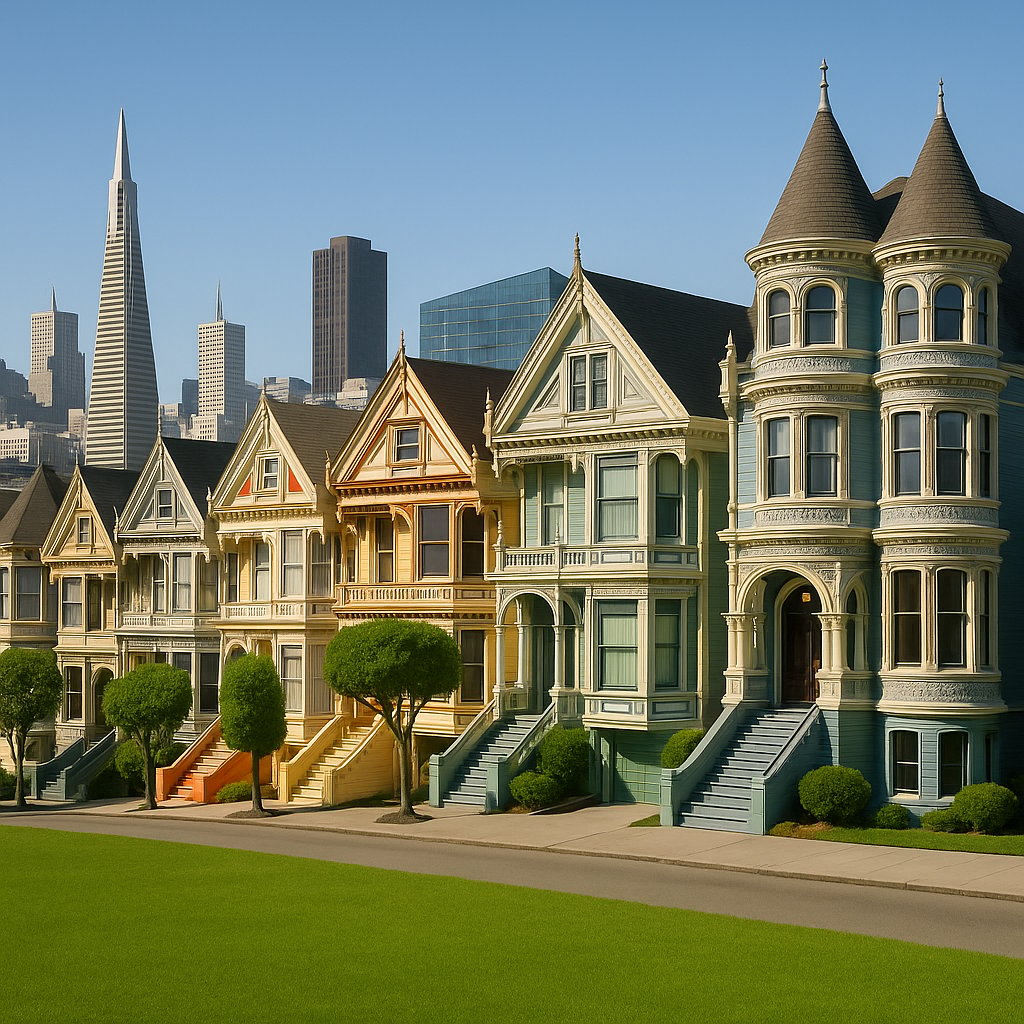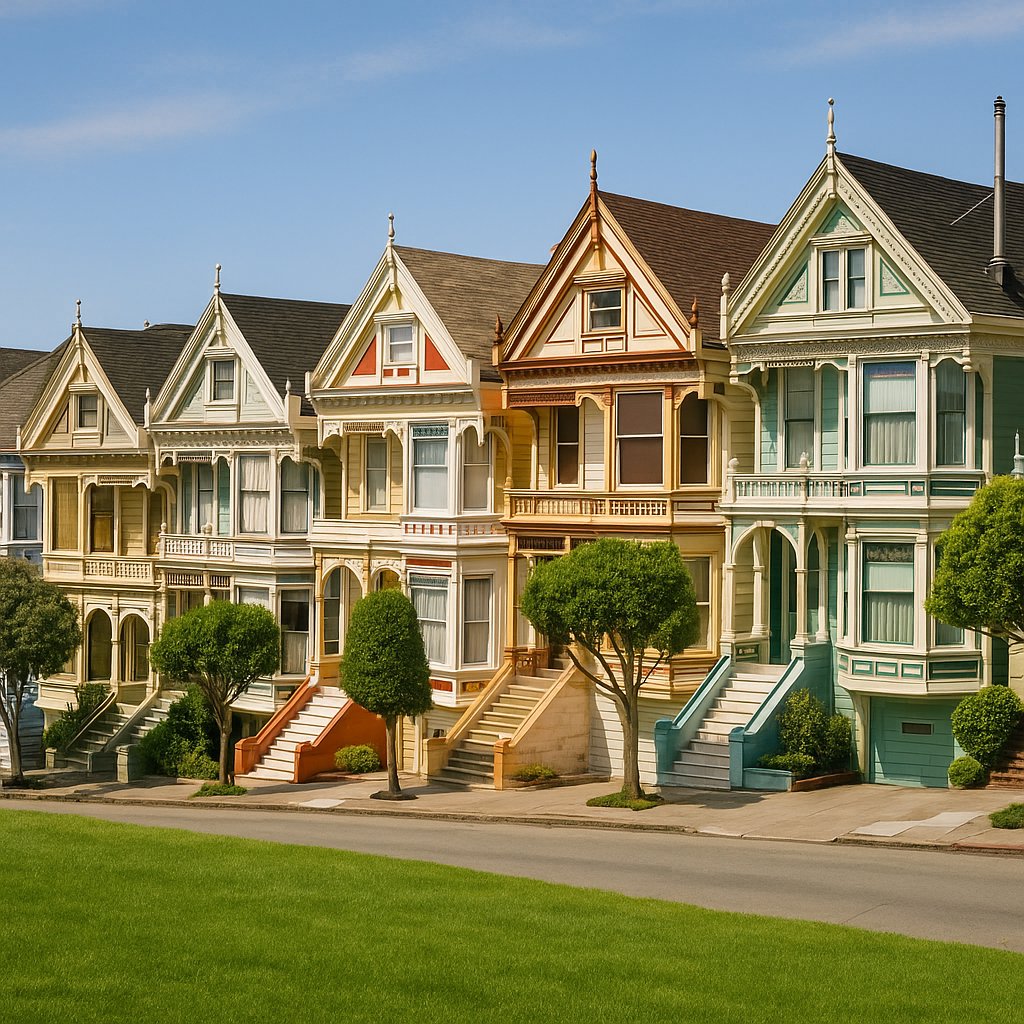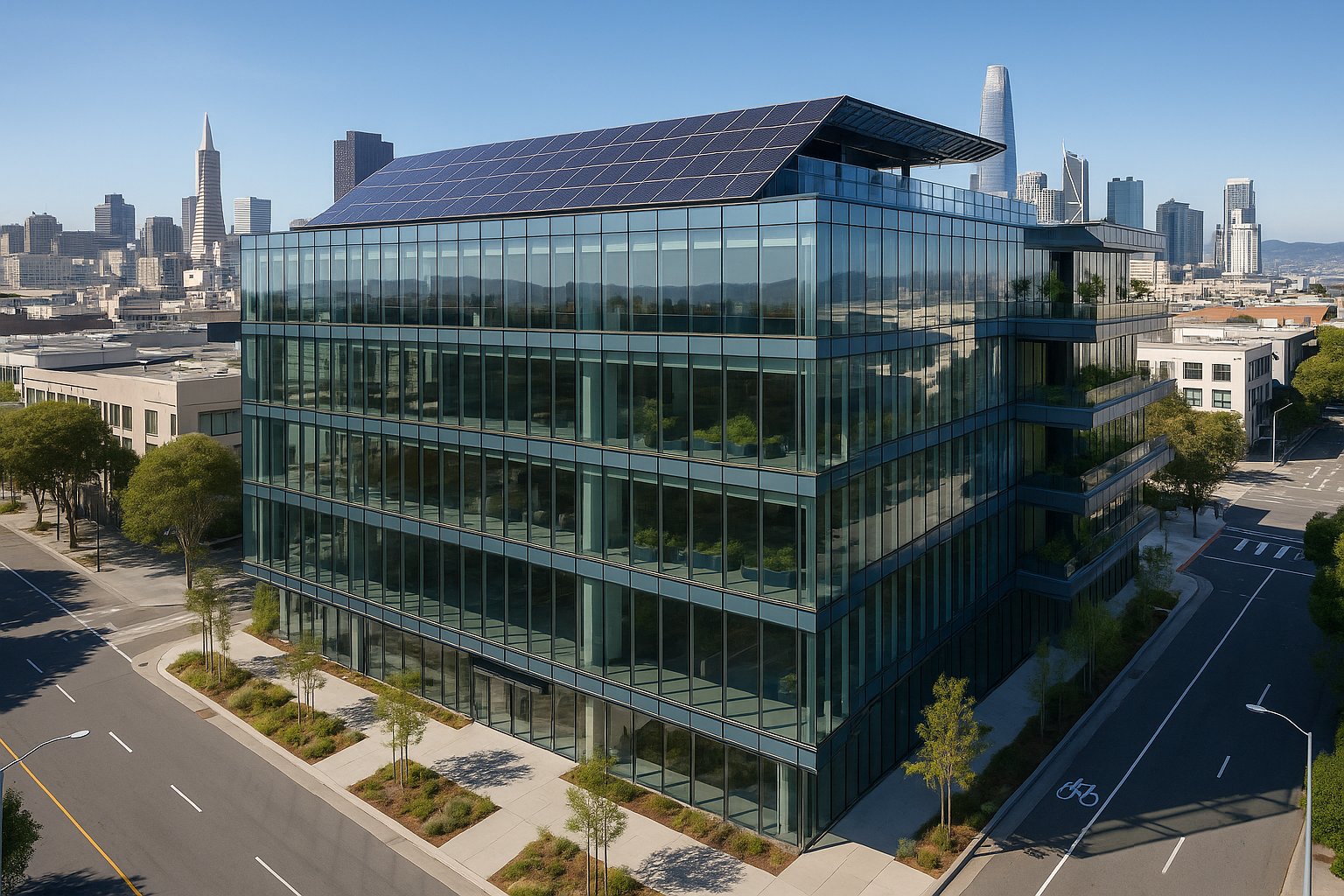San Francisco's architectural landscape tells a remarkable story of resilience, innovation, and cultural evolution. From the elaborate Victorian homes that survived the devastating 1906 earthquake to the cutting-edge sustainable buildings that define the city's modern skyline, this urban environment represents one of the most diverse and influential architectural collections in the United States.
The Golden Age of Victorian Architecture
San Francisco's Victorian heritage stands as one of the most significant architectural legacies in American history. Between 1849 and 1915, an estimated 48,000 Victorian and Edwardian-style houses were constructed throughout the city, representing a period of unprecedented prosperity during the California Gold Rush era. These elaborate structures were symbols of wealth and social status, with homeowners seeking to display their newfound affluence through ornate architectural details and craftsmanship.
The famous "Painted Ladies" of Alamo Square have become synonymous with San Francisco's Victorian identity. Built between 1892 and 1896 by developer Matthew Kavanaugh, these Queen Anne-style homes exemplify the architectural grandeur of the era. However, the vibrant colors that define these iconic structures today are actually a relatively recent addition - the result of a "colorist" movement that began in the 1960s, when artists like Butch Kardum and Maija Peeples transformed previously gray-painted homes into the colorful spectacle that attracts millions of visitors annually.
The timeless elegance of San Francisco's iconic Victorian homes.
The Great 1906 Earthquake and Victorian Survivors
The devastating 1906 earthquake and subsequent fires destroyed much of San Francisco's Victorian housing stock, with most of the estimated 40,000 Victorian homes lost during this catastrophe. However, the structures that survived this disaster have become particularly precious, representing remarkable examples of both architectural craftsmanship and engineering resilience.
Many Victorian homes that survive today required significant restoration efforts following the earthquake. Some homes slipped right off their brick and mortar foundations during the tremors, while others required extensive seismic retrofitting to ensure long-term stability. The process of "tying the house together" by bracing walls and bolting wooden structures to their foundations became a standard practice for Victorian preservation.
Three Distinct Victorian Architectural Styles
San Francisco's Victorian architecture encompasses three primary styles, each with distinctive characteristics that reflect different periods and design philosophies.
Queen Anne Victorian Style
The Queen Anne style represents the most ornate of San Francisco's Victorian architectural expressions. These homes feature asymmetrical facades, decorative woodwork, and elaborate bay windows. Distinctive elements include prominent towers, wraparound porches, and intricate "gingerbread" trim that demonstrates the exceptional craftsmanship of the era. The style typically incorporates contrasting colors and textures, elaborate rooflines, corner towers, and turrets.
Queen Anne Victorian architecture in San Francisco featuring characteristic turrets, bay windows, and elaborate decorative elements
Italianate Victorian Architecture
Italianate Victorian homes dominate neighborhoods like Pacific Heights and Noe Valley, characterized by their flat roofs, ornate cornices, and tall, narrow windows. These elegant structures feature elaborate brackets under the eaves and decorative window hoods that create dramatic shadows and visual interest. The style often includes angled bay windows, front porches with columns reminiscent of ancient Rome, and false fronts with cornices designed to make buildings appear taller.
Stick-Eastlake Victorian Design
The Stick-Eastlake style emphasizes linear elements and geometric patterns, featuring decorative "stick work" applied to exterior walls. This architectural approach represents a uniquely American interpretation of Victorian aesthetics, with intricate woodwork and angular designs that reject the curved shapes typical of French Baroque Revival styles12. The style is characterized by square bay windows, geometric-looking decorations, and patterns featuring rectangles and triangles.
Modern Luxury Architecture: San Francisco's Contemporary Renaissance
While Victorian homes capture San Francisco's historical essence, the city's modern luxury architecture demonstrates its continued evolution as a global design destination. Contemporary developments seamlessly blend cutting-edge technology with sustainable design principles, creating environmentally conscious homes that maintain the highest standards of luxury living.
Modern luxury architecture in San Francisco featuring sustainable design elements and contemporary glass facades
Sustainable Luxury in Urban Design
San Francisco has emerged as a leader in sustainable luxury architecture, with the United States Green Building Council certifying over 101.5 million square feet of LEED buildings throughout the city. These structures prioritize environmental responsibility without compromising on luxury amenities, incorporating solar panels, green roofs, and energy-efficient systems while maintaining high-end finishes and sophisticated design elements.
LEED-certified buildings in San Francisco have achieved remarkable sustainability metrics. The California Academy of Sciences, dubbed "the greenest museum on the planet," features a 2.5-acre green roof that serves as a natural air conditioning system, keeping the building up to 10 degrees cooler than conventional structures. The building's photovoltaic solar collection system provides substantial energy independence while maintaining world-class exhibition spaces.
Integration with Natural Landscapes
Modern luxury architecture in San Francisco skillfully incorporates the city's unique topography and Mediterranean climate. Architects create multi-level homes that follow natural contours, featuring outdoor terraces, rooftop gardens, and seamless indoor-outdoor living spaces. These designs maximize the city's spectacular views while creating functional living environments that take advantage of San Francisco's mild temperatures and abundant natural light.
Contemporary projects like Union House in Cow Hollow exemplify this approach, featuring a clean, poured-stone panel and brushed bronze façade that references the surrounding neighborhood's architectural heritage while establishing itself as a distinctly modern structure. The building's large picture windows create transparency and continuity between interior spaces and the vibrant urban environment beyond.
Neighborhood Architectural Personalities
San Francisco's diverse neighborhoods each possess distinct architectural characters that reflect their unique histories and development patterns.
Pacific Heights: Where Victorian Meets Modern Luxury
Pacific Heights exemplifies San Francisco's architectural diversity, where meticulously restored Victorian mansions coexist with contemporary luxury developments. This prestigious neighborhood showcases Victorian, Mission Revival, Edwardian, and Château architectural styles, creating a unique urban tapestry that honors historical preservation while embracing modern design innovation.
The neighborhood's historic mansions include the Spreckels Mansion and other elaborate structures that survived the 1906 earthquake. Contemporary developments like The Pacific luxury condominium demonstrate how adaptive reuse can transform utilitarian buildings into sophisticated residential spaces, with the project converting a former 1960s dental school into luxury residences featuring champagne-colored metal panels and floor-to-ceiling glass.
Noe Valley: Victorian Charm in an Urban Village
Noe Valley's Victorian homes have been lovingly preserved and modernized, creating a perfect blend of historical character and contemporary functionality19. The neighborhood's tree-lined streets feature beautifully restored Victorian cottages with updated interiors that meet modern lifestyle demands while maintaining architectural integrity.
The area's architectural evolution reflects broader trends in San Francisco's development. Fernando Nelson, who built thousands of homes across San Francisco, left his distinctive mark throughout Noe Valley during the 1890s with two and three-story Queen Anne Victorians featuring characteristic peaked rooflines. These homes survived both the 1906 and 1989 earthquakes, maintaining the neighborhood's distinctive character across multiple generations.
Downtown and SOMA: Modern Architectural Innovation
The South of Market (SOMA) district showcases San Francisco's commitment to innovative modern architecture, with glass towers featuring sustainable design elements and mixed-use developments that create vibrant urban communities. Projects like the 5M SoMA development represent a new model for urban living, reshaping four acres into a series of open park spaces and green terraces amid buildings with office, residential, and civic programs.
SOMA's adaptive reuse projects demonstrate how industrial buildings can be transformed into sophisticated residential and commercial spaces. The SOMA Residence, Artist Gallery & Studio exemplifies this approach, converting a former auto repair garage into a 4,500-square-foot residential loft with a motorized glass roof courtyard.
The Art of Architectural Restoration
San Francisco's approach to architectural preservation sets a global standard for balancing historical integrity with modern functionality. Victorian home restoration requires specialized expertise to maintain authentic details while incorporating contemporary amenities such as updated electrical systems, energy-efficient heating, and modern kitchen and bathroom facilities.
Skilled craftsmen like Skeeter Jones have spent decades perfecting the art of Victorian restoration, with services that can cost $200,000 and take months to complete. The process involves meticulous attention to detail, from replicating original decorative trim to restoring period-appropriate hardware and window systems.
Successful restoration projects maintain original architectural elements such as decorative moldings, hardwood floors, and ornate fireplaces while seamlessly integrating modern conveniences. This delicate balance ensures that San Francisco's Victorian homes remain both historically authentic and functionally relevant for contemporary living.
Investment Value and Market Dynamics
San Francisco's architectural diversity contributes significantly to property values and investment potential. Victorian homes in desirable neighborhoods often appreciate faster than newer constructions due to their irreplaceable historical character and exceptional craftsmanship. The current median home price in San Francisco has reached $1.3 million, with properties spending an average of 80 days on the market.
Victorian homes currently for sale in San Francisco range from $849,000 to $12.9 million, with the median listing price around $1.2 million. The market demonstrates strong demand for both meticulously restored Victorian properties and innovative modern luxury developments, with buyers valuing unique architectural character alongside contemporary amenities and sustainable features.
Future of San Francisco Architecture
As San Francisco continues to evolve, architects and city planners are developing innovative approaches that honor the city's architectural heritage while addressing contemporary challenges including housing density, sustainability, and seismic safety. Future architectural projects will likely emphasize net-zero energy buildings, innovative water management systems, and designs that promote community interaction while respecting the city's unique urban fabric.
San Francisco's luxury housing market is experiencing a renaissance, driven by artificial intelligence industry growth and renewed investor confidence. This economic momentum is creating opportunities for both historic preservation projects and cutting-edge new construction that will define the city's architectural landscape for decades to come.
The city's commitment to sustainable development continues to influence architectural decisions, with new mandates requiring buildings over 250,000 square feet to install graywater recycling systems and other environmentally responsible features. These requirements ensure that San Francisco's future architectural development will maintain the city's position as a global leader in sustainable urban design.
Conclusion
San Francisco's architectural journey from Victorian grandeur to modern luxury represents a remarkable testament to urban resilience and design innovation. The city's estimated 10,000 surviving Victorian homes create a distinctive urban landscape that celebrates both historical preservation and contemporary architectural excellence. This architectural diversity provides residents and visitors with an unparalleled aesthetic experience while contributing to the city's position as a global leader in sustainable urban development.
The seamless integration of historic preservation with modern innovation ensures that San Francisco will continue to serve as an architectural inspiration for cities worldwide. Whether drawn to the intricate craftsmanship of Victorian design or the sophisticated technology of contemporary luxury developments, San Francisco's architectural landscape offers endless opportunities for both aesthetic appreciation and strategic investment in one of America's most architecturally significant urban environments.



